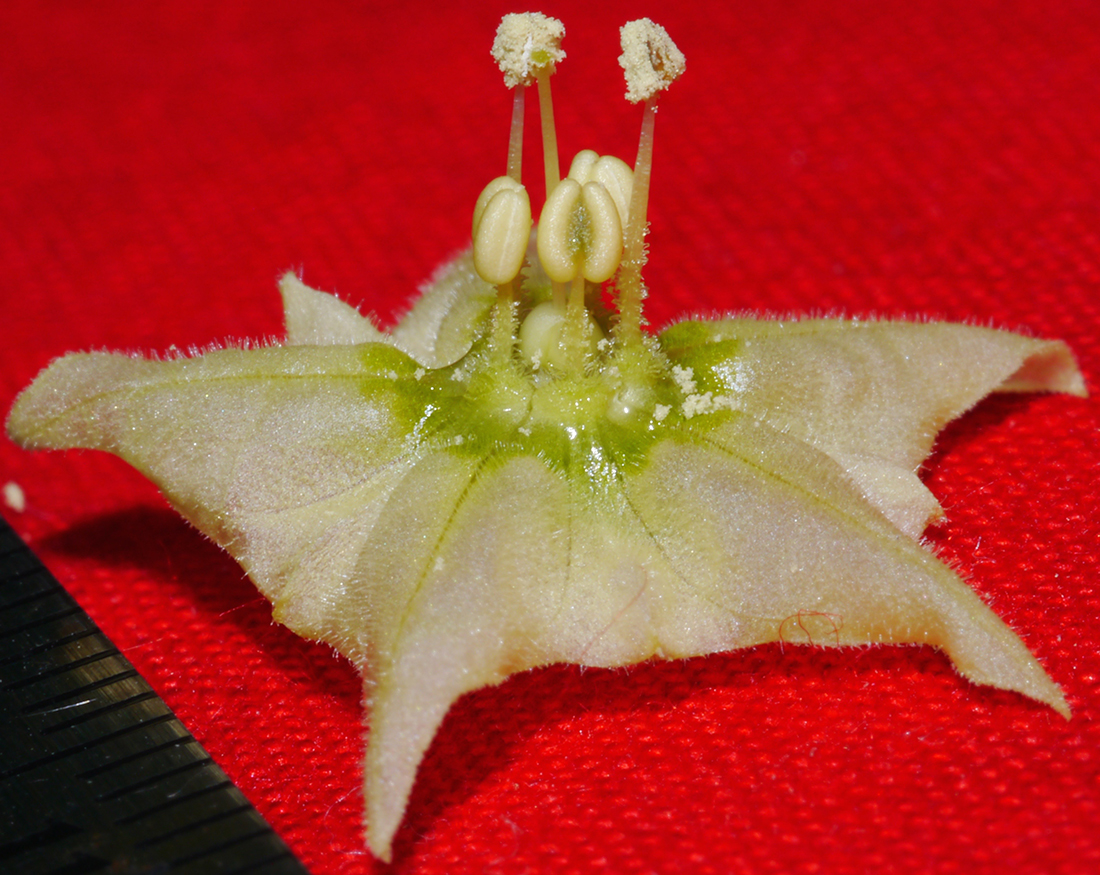
Jaltomata procumbens 321 |
Guatemala |
revised 15 Feb 2016 |
| Link to Jaltomata homepage | The information on this page may be cited as a communication with professor Thomas Mione, Central Connecticut State University, Biology Department, Copernicus Hall, 1615 Stanley Street, New Britain, CT 06050-4010 USA |
Link to the Jaltomata of Arizona (USA), Mexico and Central America |
 |
| Figure 1. Jaltomata procumbens accession 321. Note that stamens elongate at unequal rates, two anthers dehiscing prior to three. Grown in CCSU greenhouse, photo by T. M. January 2016. Units showing on a ruler in lower left are mm. |
| Jaltomata procumbens 321 | other Jaltomata procumbens | |
|---|---|---|
| Filaments | Filaments do not angle away from the style (Figures 1, 2, 3); filaments are connivent. |
Filaments angle out (away from the style) during hermaphroditic phase (see J. procumbens page) |
| Stamen elongation | Stamens elongate at unequal rates. The anthers of the longer two stamens dehisce before the other three anthers. The stamens all become the same length. |
Filaments elongate at same rate; stamens remain the same length. |
| Filaments pubescent | Yes (Figures 1, 2) |
There is variation among accessions: sometimes yes and sometimes only at base where slender part of filament meets the expanded base of the stamen. |
| Fruit Size | Small (see figure 5, below) |
Larger than 321 (see figure 5, below) |
| Pollen Size | Small see Table 5 on web page of J. procumbens |
Larger than 321 see Table 5 on web page of J. procumbens |
| Corolla Remaining Open At Night? | Yes. On 4 November 2012 I saw both wide-open and semi-open flowers at 10:30 pm (no lights were on so this is not an abberation due to an artificial environment). |
No, corolla closes for the night |
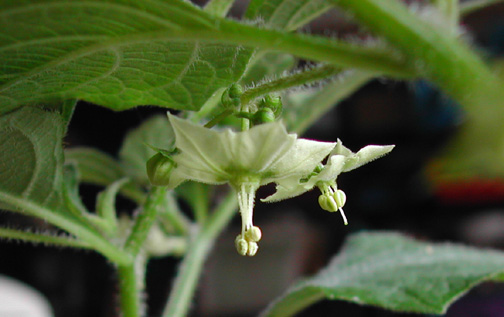 |
Figure 2. In the photo at left, the right flower is pistillate; In the photo at left, in the left flower: Note how the filaments are connivent
Photo by Thomas Mione, 2002. |
Figure 3 Flower on left is pistillate; the next day it will look
Photo by Thomas Mione, August 2002. Smallest units are mm. |
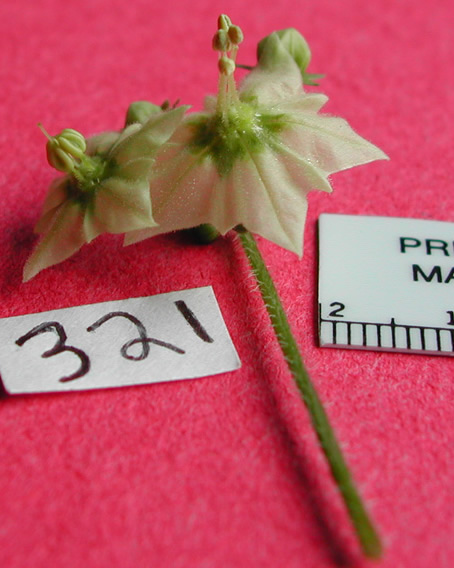 |
Figure 4. Ripe fruits
Photo by Thomas Mione, November 2002. Smallest units are mm. |
Miscellaneous Notes, accession 321: After a fruit ripens, it remains attached to the parent
plant for weeks. During the fall of 2002 I had plants growing
(under lights) and none of the ripe fruits fell to the floor. Fruits do eventually fall to the floor (greenhouse plants 2012). Seedlings Have Gland-tipped Hairs: All seedling hairs are uniseriate and unpigmented; droplets of fluid (or viscous secretion) can be seen (with a dissecting microscope) at the tips of all seedling hairs (observed years 2010, 2014). Demonstration of lack of agamospermy/parthenocarpy: Gregory J. Anderson emasculated 10 flowers on two plants of accession 321 in the University of Connecticut greenhouse, while filaments were short and anthers were undehisced. Zero fruits were set on plants that otherwise abundantly self-set fruit in a pollinator-free greenhouse. |
| Figure 5. Ripe fruits of 321 are smaller than those of other accessions of J. procumbens (represented by accessions 580 and 599). Units are mm, photo by Emmett P. Varricchio 2012. |
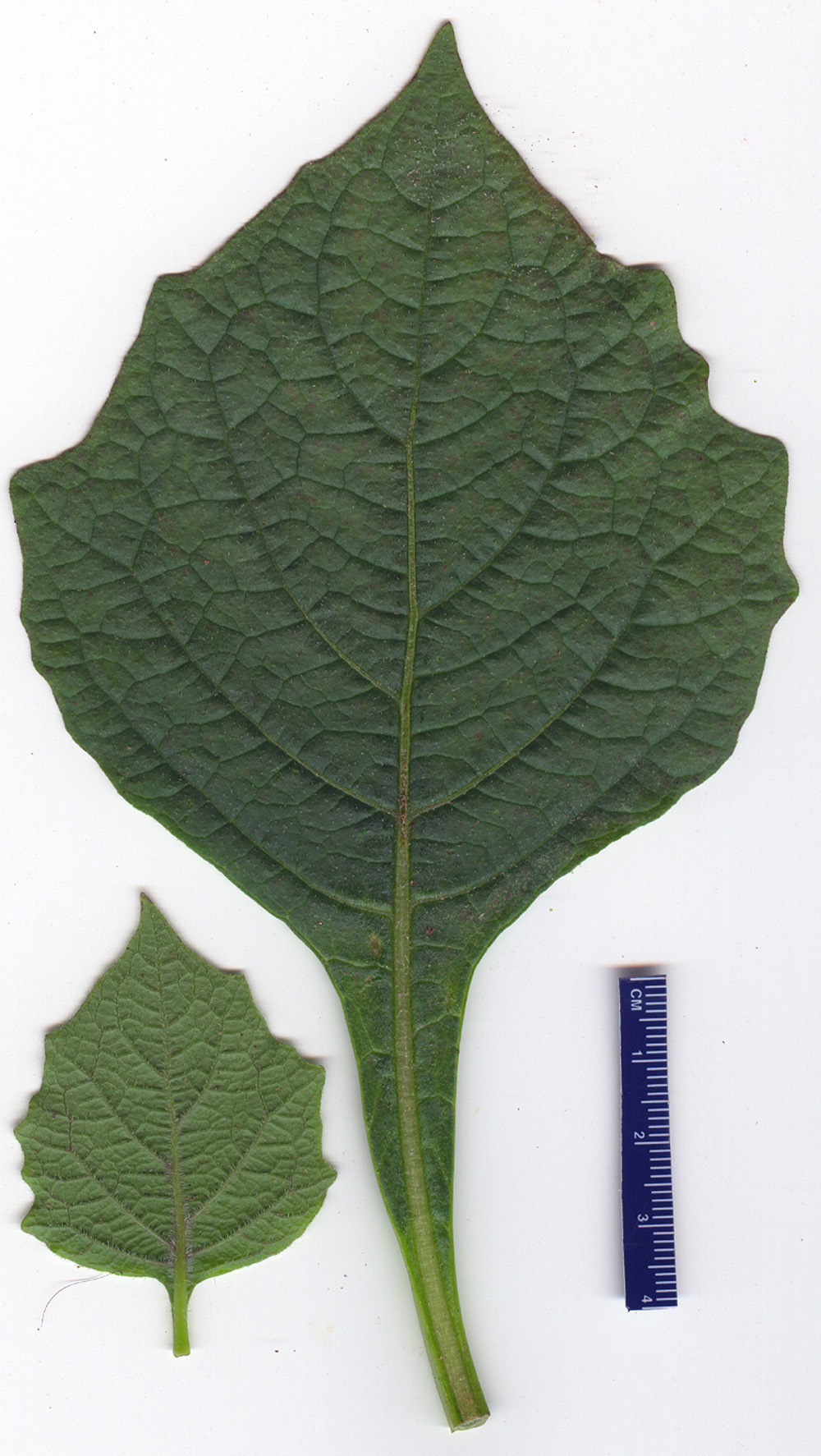 |
| Figure 6. Above: Smaller leaf with underside showing, larger leaf with upper side showing. The larger leaf was chosen because it was about the largest healthy leaf. Scanned by T. Mione 17 Aug 2010, accession 321. |
| Figure 7. Below: Smaller leaf with upperside showing, larger leaf with underside showing. These two leaves are the same leaves shown in Figure 5. Scanned by T. Mione 17 Aug 2010, accession 321. |
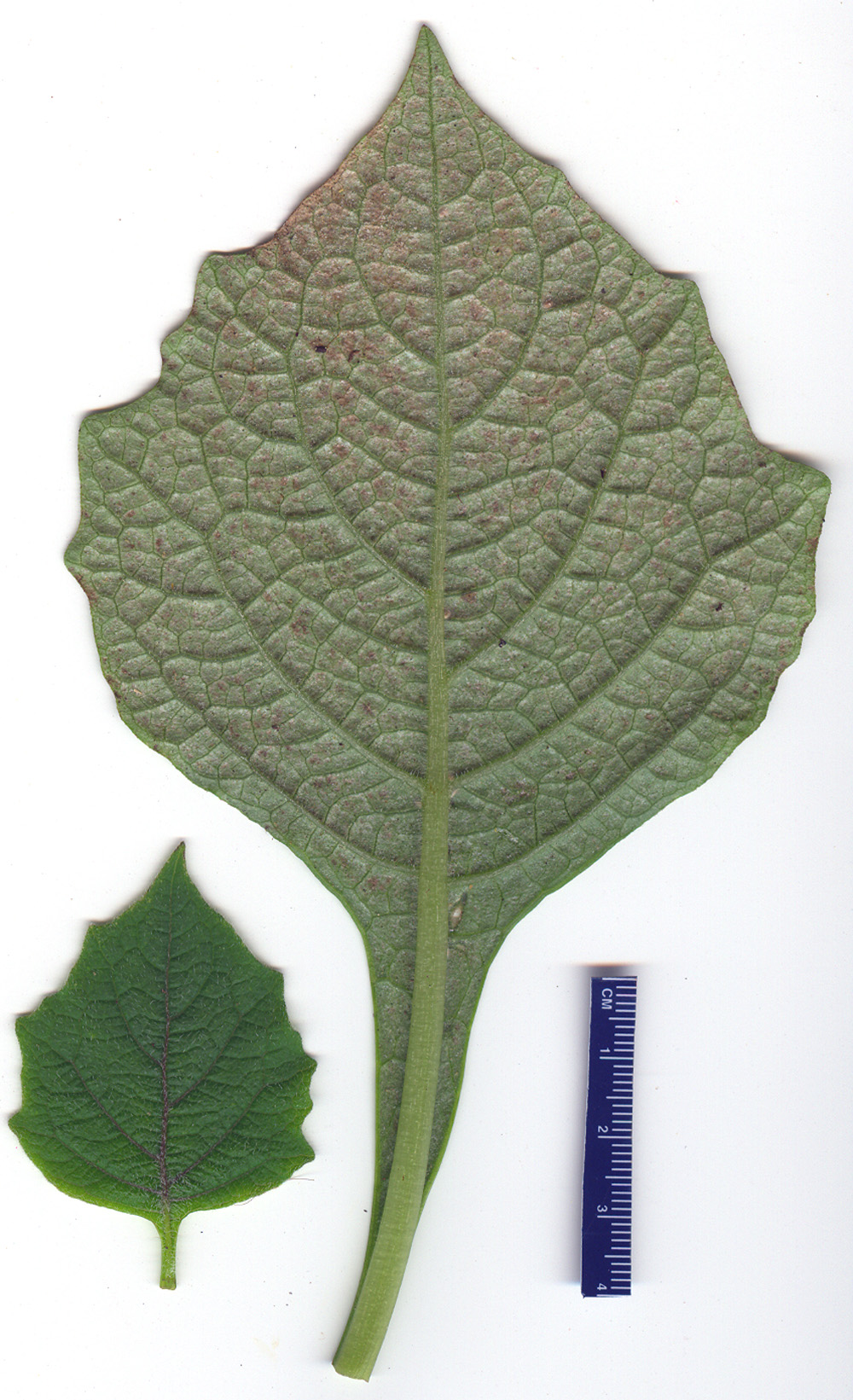 |
pollen recipient listed before pollen donor |
date of cross |
result |
tag # |
| 321 X 590 | 11 Aug 2010 | fail, tag removed 17 Aug 2010 | 2010 - 3 |
| 321 X 590 | 11 Aug 2010 | fail, tag removed 17 Aug 2010 | 2010 - 4 |
| 321 X 590 | 12 Aug 2010 | fail, tag removed 17 Aug 2010 | 2010 - 5 |
| 321 X 590 | 17 Aug 2010 | fail, tag removed 3 Sept 2010 | 2010 - 8 |
| 321 X 590 | 17 Aug 2010 | fail, tag removed 23 Aug 2010 | 2010 - 9 |
| 321 X 321 | 18 Aug 2010 | fail. Control for interaccession crosses done on similar dates | 2010 - 11 |
| 321 X 590 | 20 Aug 2010 | fail, tag removed 28 Aug 2010 | 2010 - 19 |
| 321 X 321 | 20 Aug 2010 | fail. Control for interaccession crosses done on similar dates | 2010 - 21 |
| 321 X 321 | 20 Aug 2010 | fail. Control for interaccession crosses done on similar dates | 2010 - 22 |
| 321 X 590 | 28 Aug 2010 | fail, tag removed 3 Sept 2010 | 2010 - 31 |
| 321 X 590 | 28 Aug 2010 | fail, tag removed 9 Sept 2010 | 2010 - 32 |
| 321 X 321 | 28 Aug 2010 | fail. Control for interaccession crosses done on similar dates | 2010 - 33 |
| 321 X 321 | 28 Aug 2010 | fail. Control for interaccession crosses done on similar dates | 2010 - 34 |
| 590 X 321 | 17 Aug 2010 | Showed some ovary expansion on 24 Aug. On 8 September, an immature fruit. On 21 September I noticed that the fruit had fallen off and was nowhere to be found. Aborted or lost. | 2010 - 6 |
| 590 X 321 | 17 Aug 2010 | Showed some ovary expansion on 24 Aug. On 8 September, an immature fruit. On 21 Sept I noticed that the fruit was still very small for 590, and the fruit dropped off when I gently touched it. I smashed the fruit and I noted that the seeds (with a dissecting microscope) all looked nonviable (very flat/thin). | 2010 - 7 |
| 590 X 321 | 27 Aug 2010 | Fruit, harvested 10 Oct 2010, gave 13 viable looking seeds and 18 non-viable-looking seeds | no tag number |
| Thoughts about the above data: Jaltomata 321 has self-set fruits in the past. Given that crosses of 321 with itself failed, the failure of crosses between accessions is meaningless. It was probably too hot for sexual reproduction. In September 2010, when temperatures were cooler, plants of these accessions prospered. |
From Gregory J. Anderson to T.M.
I marked 3 flowers each on two plants of accession 321, and followed them since Monday. All open and in pistillate phase on Monday. On Tues daytime, flowers open (no surprise) and in various phases of H.
Tues NIGHT – flowers open –mostly, and in H state, with anthers connivent around the style (or at least long, and touching each other) – but open. One fl had a slightly less reflexed/rotate corolla – but, in general the fls were all open.
That was not the case for any of the other Jaltomata on benches 1 and 2 – they all had fls where the corolla was ‘closed’ to some extent around the primary sex organs. Most but not all of the 321s were pendant, so presumably would avoid getting wet from rain or dew in that way, but they behaved very differently than the other accessions. I went twice: at 6:30 (dark) and again at 9:30. It seemed that the other species were more closed at the later time than earlier.
Is there any scent? I did not detect any overwhelming scent, but I wonder if the 321s might emit a scent to attract moths? – if they are open at night?
Seed Germination:
accession |
planted |
germinated |
Germination in __ days |
Stored Since |
Heat Mat On (underneath) |
| 321 | 2 May 2006 | 13 or 14 May |
11 or 12 |
2004 |
probably not |
| 321 | 30 March 2010 | 20 April 2010 |
21 |
2004 |
no data |
| 321 | 28 April 2010 | 9 May 2010 |
11 |
Fall 2004 |
no data |
| 321 | 21 October 2014 | 28 October 2014 |
7 |
Fall 2004 |
yes |